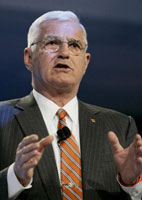 Top international experts meeting in Rome last week agreed that bioenergy could be a positive force for rural development
Top international experts meeting in Rome last week agreed that bioenergy could be a positive force for rural development
According to a news release from the Food and Agriculture Organization (FAO) it was the first time that experts in bioenergy, food security and the environment came together to discuss the environmental and food security impact of the rapidly-expanding bioenergy industry.
Alexander Müller, head of FAO’s Natural Resources Management and Environment Department, said, ‘While there is legitimate concern among some groups that bioenergy could compromise food security and cause environmental damage, it can also be an important tool for improving the well-being of rural people if governments take into account environmental and food security concerns.”
During the meeting, Luiz Augusto Horta Nogueira is Professor at the ‘Universidade Federal de Itajubá’, Brazil said some crops are more productive than others when it comes to making ethanol and biodiesel.
“The conflict between food and fuel should be evaluated under this point of view,” he said. “If you are considering the good options you have in wet, tropical countries this conflict is not so serious.” He says that sugarcane for ethanol and palm oil for biodiesel are more efficient than corn and soybeans.
Listen to interview here:  FAO Energy 1 (2 min MP3)
FAO Energy 1 (2 min MP3)
Seth Shames, Policy Program Manager of the Washington-based Ecoagriculture Partners says bioenergy could have great benefits for small farmers in countries such as Africa and Central America.
“We’re excited about potentials for growing biofuel crops, trees or even perennial grasses in the future, which could be used by small farmers for their own energy needs to integrate in the food landscape also so they don’t have to make this trade-off and also increases livelihood options for them,” he said.
Listen to interview here:  FAO Energy (2 min MP3)
FAO Energy (2 min MP3)
 Ethanol and the Indy Racing League will be in the spotlight at the National Agricultural Center & Hall of Fame 2007 Annual Meeting Thursday in Bonner Springs, KS.
Ethanol and the Indy Racing League will be in the spotlight at the National Agricultural Center & Hall of Fame 2007 Annual Meeting Thursday in Bonner Springs, KS. 



 A New Zealand technology company has secured $3.5 million in private venture capital to develop ethanol from carbon monoxide.
A New Zealand technology company has secured $3.5 million in private venture capital to develop ethanol from carbon monoxide.  International investment and advisory firm
International investment and advisory firm  In January 2006, Babcock & Brown Environmental Investments completed the acquisition of Diversified Energy Company, whose primary asset is a 25 mgpy facility in Morris, Minnesota. Babcock & Brown also has two plants under construction: a 100 mgpy facility in Hennepin, Illinois and a 50 mgpy facility in Necedah, Wisconsin.
In January 2006, Babcock & Brown Environmental Investments completed the acquisition of Diversified Energy Company, whose primary asset is a 25 mgpy facility in Morris, Minnesota. Babcock & Brown also has two plants under construction: a 100 mgpy facility in Hennepin, Illinois and a 50 mgpy facility in Necedah, Wisconsin. If the Iowa Utilities Board approves it, an expansion by a major wind energy producer in Iowa will nearly double that state’s wind power generation capacity.
If the Iowa Utilities Board approves it, an expansion by a major wind energy producer in Iowa will nearly double that state’s wind power generation capacity.  MidAmerican currently runs 323 wind turbines at three sites in northwest, north central and west central Iowa, generating 459.5 MW of electricity. That’s enough power for about 144,000 homes.
MidAmerican currently runs 323 wind turbines at three sites in northwest, north central and west central Iowa, generating 459.5 MW of electricity. That’s enough power for about 144,000 homes.  “The city of San Francisco departments have announced various strategies using biodiesel to reduce air pollution and greenhouse gases, and to use local resources to produce biofuels,” said Randall von Wedel, a biochemist representing the National Biodiesel Board (NBB) in state regulatory affairs, based in the San Francisco area. “We are grateful to Mayor Newsom for his initiative,” said von Wedel, “and we hope that San Francisco will serve as a model for other large cities on how to make a difference in reducing air pollution, greenhouse gases and dependence on petroleum fuel.”
“The city of San Francisco departments have announced various strategies using biodiesel to reduce air pollution and greenhouse gases, and to use local resources to produce biofuels,” said Randall von Wedel, a biochemist representing the National Biodiesel Board (NBB) in state regulatory affairs, based in the San Francisco area. “We are grateful to Mayor Newsom for his initiative,” said von Wedel, “and we hope that San Francisco will serve as a model for other large cities on how to make a difference in reducing air pollution, greenhouse gases and dependence on petroleum fuel.” The vice chairman of General Motors says converting automobiles to ethanol is “entirely realistic.”
The vice chairman of General Motors says converting automobiles to ethanol is “entirely realistic.” Scientists have used an SDSC supercomputer to help improve cellulose conversion to ethanol.
Scientists have used an SDSC supercomputer to help improve cellulose conversion to ethanol.  Top international experts meeting in Rome last week agreed that bioenergy could be a positive force for rural development
Top international experts meeting in Rome last week agreed that bioenergy could be a positive force for rural development 